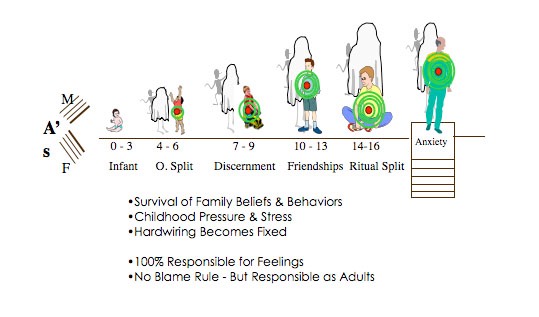
This slide shows the five stages of early childhood conditioning and a sixth as a fully hardwired adult. During the first four stages we learn what to feel, how to be in relationship and when to communicate with others. This conditioning becomes the default model for feelings, relationships & communications during the rest of our lives. The fifth stage, ritual split, is a time when we compared our family’s model to other families we experience.
Infant:
Before birth, internal and external forces were already conditioning us. Sounds, moods and environmental stimuli influenced our mother. Add to this mix our genetic inheritance, and at birth, we have fertile ground for the creation of our personality, future possibilities and limitations. In the infant years, our parent’s beliefs and behavior molded our relationship and communication model. We had no choice in this process. The two development stages that surface when parents’ talk about the difficult stages of child rearing are the terrible 2’s and the troublesome teen years. We will cover the 2’s here and the teen years a little further along. The “terrible two’s” are a product of natural development. It is not because we were ill mannered or evil at that age! The facts are, that as two year olds, we were finally physically and cognitively mature enough to react to our caregiver’s relationship & communication model. We were instinctively aware of what was missing, unfair or hurtful. We tested our parent’s relationship knowledge, tried out various behaviors to get attention and began to feel the powerful effects of their authority. We have to remember that our parent’s hardwiring was fixed. They reacted to our behaviors according to their “normal” beliefs, feelings and behaviors. If we were raised in a family where our 24-month behavior was seen as natural, and our parents had a container to embrace them, our acting out would just be another phase of childhood. Instead, it is often a period of trial and frustration.
Original Split:
Within the next development stage, one to three years of age, the natural psychic tension that has been building up comes to a head. The tension is between our inner, independent SELF and our outward BEHAVIOR. The degree of tension is subject to our parents default patterns of thinking, acting, communicating and getting attention. As time went by, our caregivers enforced these behavior and belief norms to the exclusion of our independent Self – our personal feelings.
At the same time, two wounds were created. First - the RED DOT above - represents a natural wound resulting from the conditioning received from caregivers. These conditioning wounds left us with physical and emotional scars that say, “I am not ok the way I am. I must act in a way that is acceptable according to caregivers expectations.”
Examples would be:
“Don’t run into the street!”
“Do not play with knives!”
“Do not touch that!”
“Don’t paint on the walls!”
“Don’t eat that “
The second wound - the GREEN CONCENTRIC CIRCLES above - represents normal wounds resulting from strong feelings we had that were contrary to our parents feelings of ‘right’ & ‘normal.’ We might feel, “My feelings are not the right feelings. I must bury my feelings and pretend to feel like my parents to survive. I must not express my feelings if I want to stay safe.”
Examples:
“There is nothing to cry about!”
“I’ll give you something real to cry about!”
“You should feel ashamed of yourself!”
“You are so selfish!”
“You should be more like your cousin!”
Eventually, because of the tension between self and behavior expected by caretakers, the psyche must split to remain safe and co-exist with caregivers. This is a natural effect of the psyche under extreme stress or pressure. In this situation two separate personalities emerge:
First, the Survival Child, whose job it is to get attention at any price. It is not always logical, consistent, empathetic, polite or necessarily honest. Yet, at times, it may be all of these if survival is threatened. The Survival Child does not mature with time, as we become adults. The Survival Child will remain the age at which it split off from the psyche. For most of us this is between one and three years of age.
The second survival split is the Golem* or Enforcer, who’s job it is to learn, record and enforce the normal beliefs and behaviors of the caregivers whenever stressful conditions are present in our environment. The Golems enforcement is dogmatic and repetitive. It matters not if results are achieved, as long as “normal” beliefs and behaviors are maintained. We may be unhappy, but feel justified in our behavior. Survival is the primary drive.
Remember, neither the Survival Child or Enforcer personalities are simply evil or virtuous. They are some mixture of the two. Based on our unique conditioning, they make us act out habitually during times of stress. Habitually enforced by what we learned from our caregivers. Their job is to help us survive, continuing into adulthood, even when a perceived threat is unfounded.
There are many positive qualities also associated with the Survival Child or Enforcer reactiveness. For example they answer the phone, drive through heavy traffic or bad weather, automatically making any needed adjustments. They help us attract friends and partners. They can act as coaches in sport competitions or childbirth. They are highly competent in any repetitive or habitual task.
Discernment
In this period, we begin to discern between bad, good, better and best. We are no longer parroting what others tell us. We know that smoking has harmful effects, eating too much will make you sick and stealing has consequences. Conditioning becomes hardwired and default reactions more pronounced in our relationships with family and friends.
Friendship (Page 8 Notes: See External Search, Comparison and Projection.)
Between ages 10 through 13, we venture outside the family hardwiring. We visit and stay friend’s houses and see different models of behavior and beliefs. A comparison of communication & relationship models, and home environments, starts a process of conflict within or refinement of the family’s hardwiring. If the home environment is open to learning about the many different ways of being, there will be a healthy dialogue with parents and little conflict will occur. If parents are threatened by difference, explorations into other systems will be crushed and feelings repressed.
Contributing to this is the rush of hormones passing through our pre-teen bodies as puberty takes over. This comparison of models and the effects of puberty can make the teen years troublesome. However, if parents have adequate skills to carry on dialogues with offspring, conflict can be minimized.
Ritual Split
The ritual split differs from the original split in several ways. The original split is a fact of nature. No matter the skill level of the caregivers, we as children cannot remain animals working from instinct. Some form of conditioning must take place, thus, a split must occur. Socialization is a natural sequence of conditioning. Finally, the original split can vary in degree from functional to dysfunctional, dependent on the caregiver’s own conditioning.
Adult
As an adult, we can look at something as simple as our preferences for signs of hardwiring. We can have others give us feedback on our behavior when they observe us in relationships with co-workers, friends, siblings, parents, authority figures, store clerks and waitpersons. From this feedback, patterns will emerge that suggest a personal and professional style of relating. This style works fine for the majority of our communications. However, there are important relationships that require communication skills that can move the conversation beyond hardwired styles to the core intentions of the people involved. This is where Core Intentional Language belongs.
*Golem - The word golem derives from the Hebrew golem, meaning ‘shapeless man’ or 'unformed material'. In Jewish folklore, a golem resembles a human being yet is an artificial figure, a robot-like being, often created from clay or mud, and endowed with life through the use of magical language (Truth–Death). Artificially brought to life the golem is capable of threatening its creator. Though endowed with almost all human faculties, the Golem is mute and cannot speak. His function is to hear and to execute the commands of his master, which he does without either will or reason. The Golem is invariably represented as a protector when humans are in despair of divine or dependable aid.
Copyright © 2020 Scott Taylor Consulting All Rights Reserved.
